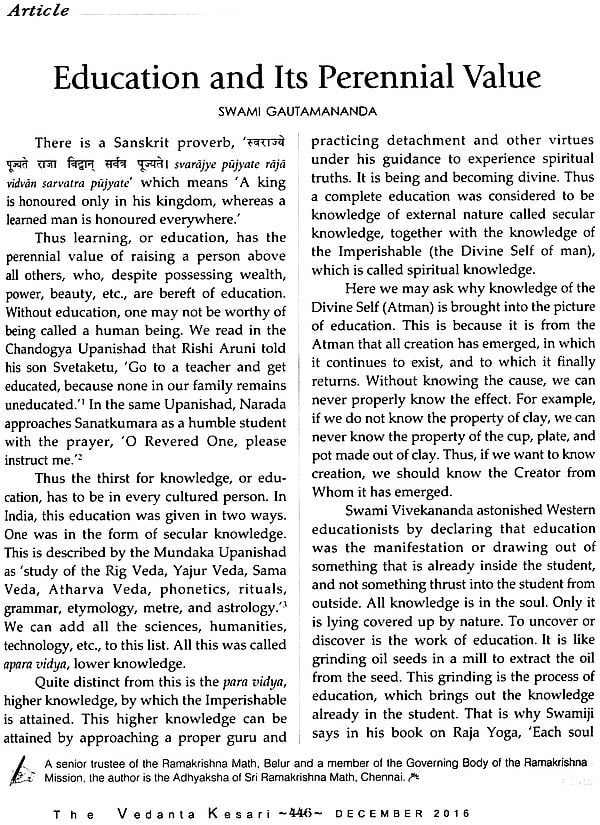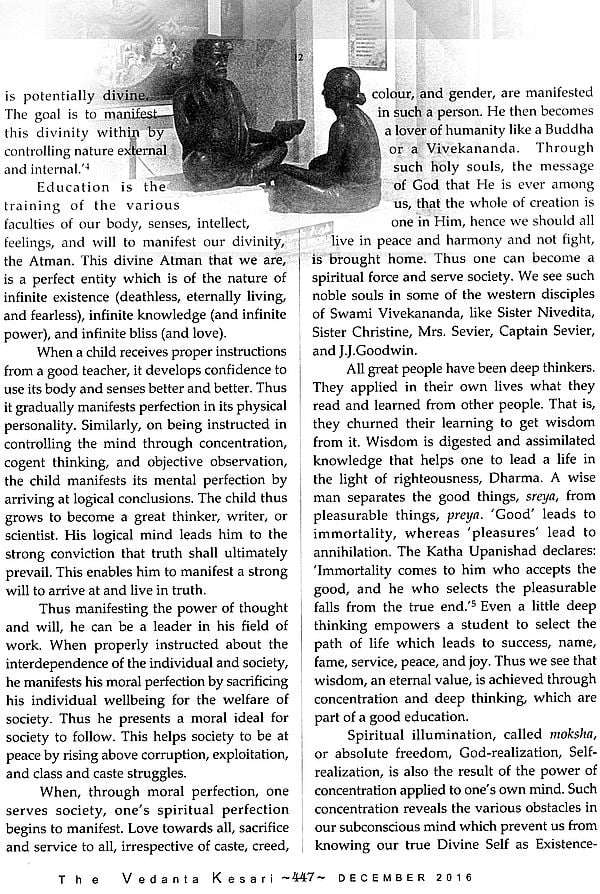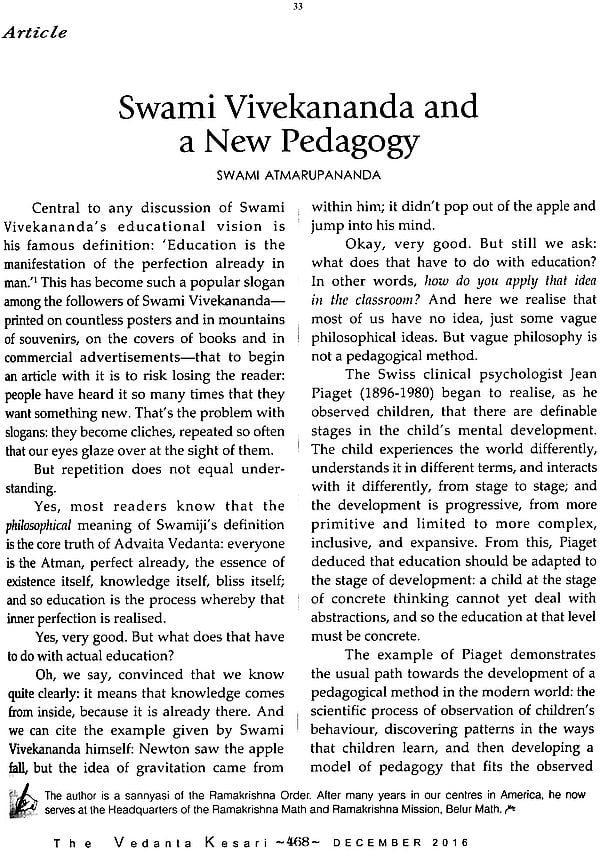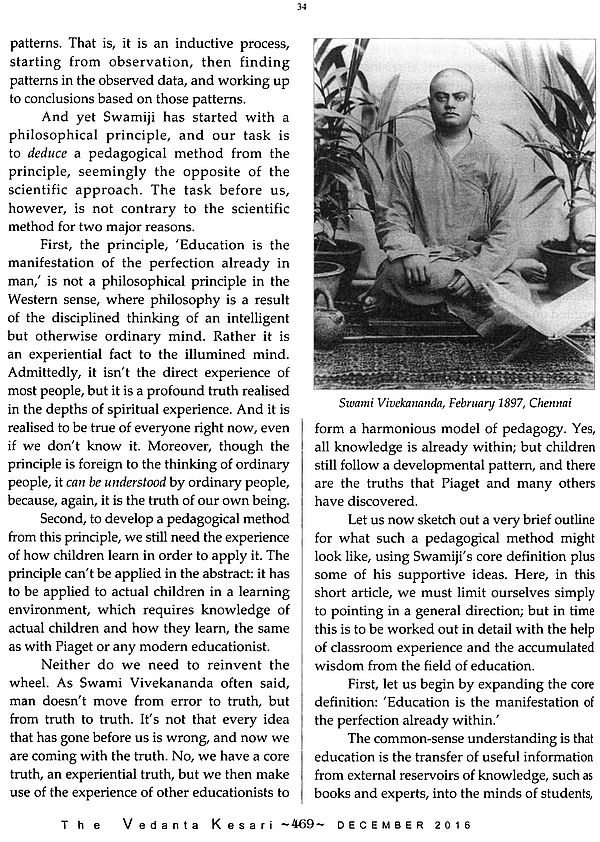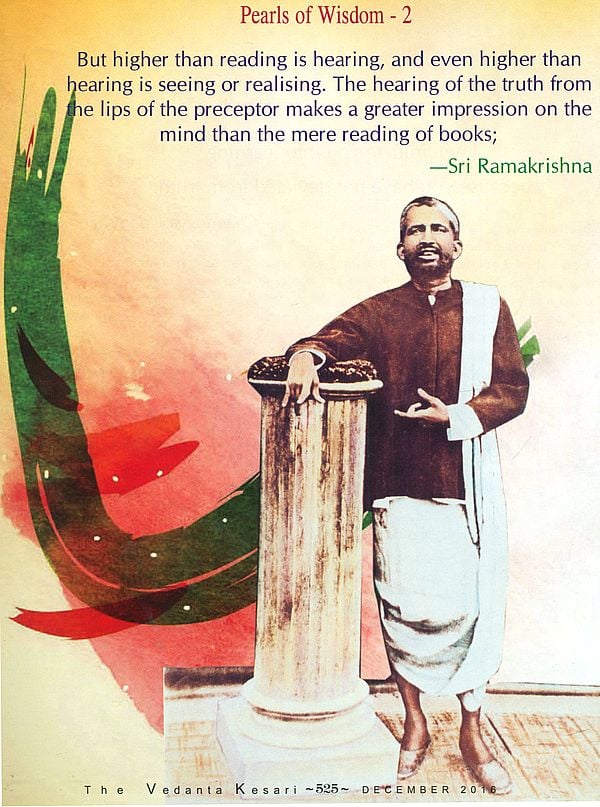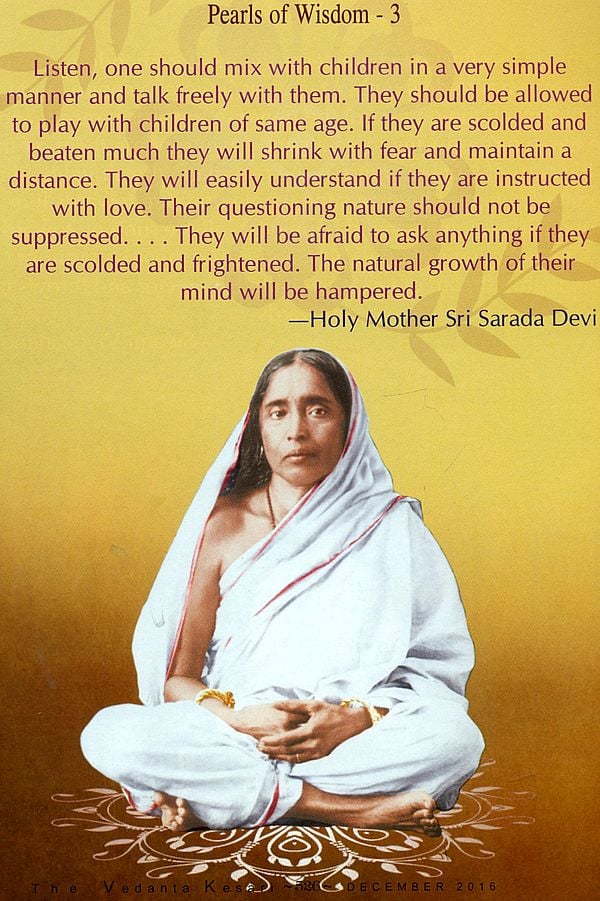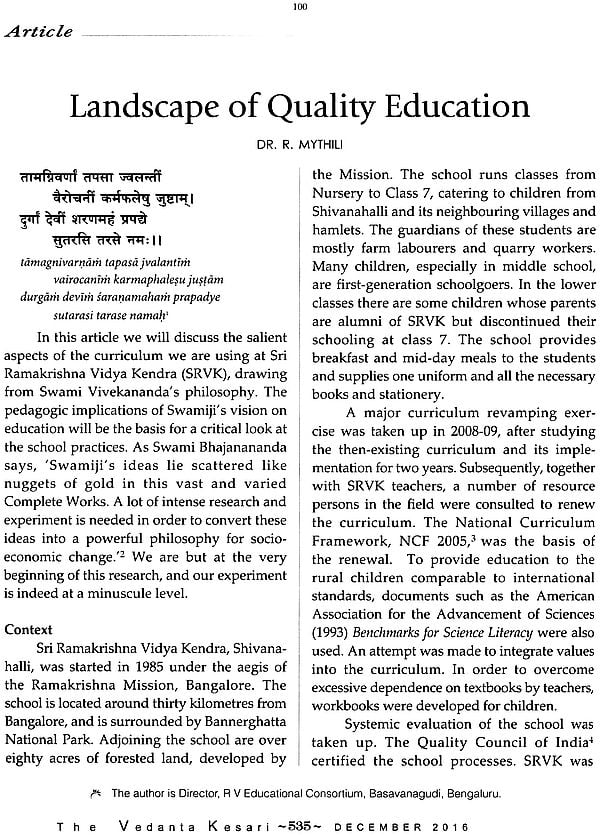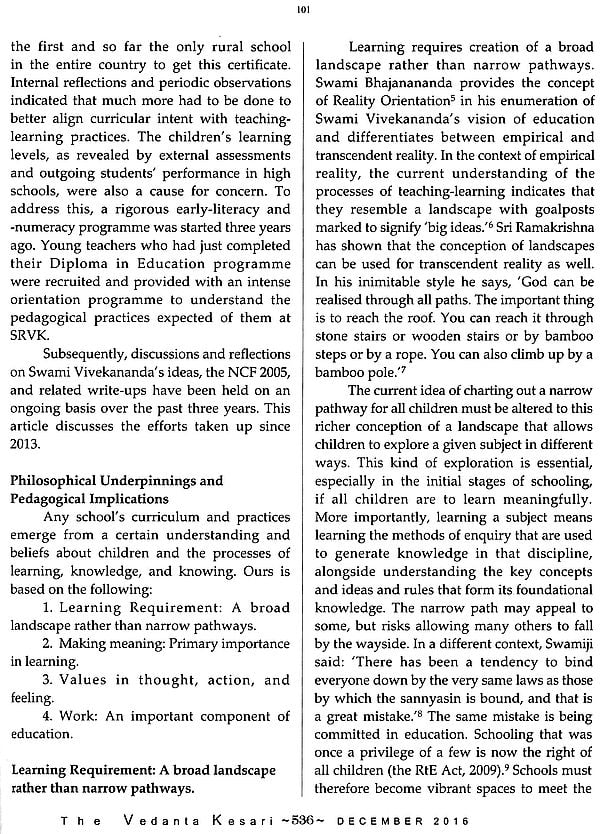
Swami Vivekananda (The Man and His Message)
Book Specification
| Item Code: | NAG957 |
| Publisher: | Ramakrishna Math |
| Language: | English |
| Edition: | 2016 |
| ISBN: | 9770042298000 |
| Pages: | 234 (Through out B/W Illustrations) |
| Cover: | Paperback |
| Other Details | 9.0 inch X 7.0 inch |
| Weight | 340 gm |
Book Description
The thing that held me in Swamiji was his unlimitedness. I never could touch the bottom – or top – or sides. The amazing size of him! ...
In these few words, Josephine Macleod, a western 'friend' of Swami Vivekananda, says it all about Swamiji's personality and message. It was his unlimitedness, boudlessness, vastness-in every way-that astounds anyone who reads his life and descriptions of his personality, and goes through his nine-volume Complete Works. He, his life and his message, are truly amazing. What is even more, how could he accomplish so much in such a short life-span of less than 40 years?!
One hundred and fifty years have passed by since the great Swami was born. Much water has flowed through the river of history since then, yet his message continues to shine like sun-ever-resplendant and ever fresh. We might as well join Professor John Henry Wright of Harvard University who told Swami Vivekananda: 'To ask you, Swami, for your credentials is like asking the sun about its right to shine,' and say, 'To ask if Swami Vivekananda's message is relevant today is to ask the sun of its relevance today!'
Voices of Silence
But, then, who was Swami Vivekananda? Though the toughest question to answer, the introduction to the life of Swami Vivekananda published by the Advaita Ashrama answers it befittingly and vividly thus: Coming from afar are the voices of the Silence. Rarely are they heard, save by mystics and sages. And when one of these voices becomes embodied as sound audible to mortal hearing, blessed is the time and blessed are those who hear. Formless is the Spirit and subjective is the vision thereof; dense is the illusion that hangs as the cosmic veil before Reality! How divine, therefore, must be the personality that makes objective the vision of the Spirit! How priceless the history of one who has lifted even a fringe of the veil! The illusion becomes transparent in the effulgence of such a spiritual personality. Verily, the Spirit Itself becomes revealed; and those who see are brought face to face with Reality!
To introduce the life of Swami Vivekananda is to introduce the subject of spiritual life itself. All the intellectual struggle, all the doubts, all the burning faith, all the unfolding process of spiritual illumination were revealed in him. As a man and as a Vedantist he manifested the manliness that is sanctity, and the sanctity that is manliness; he manifested the patriotism that proceeds from the vision of the Dharma and the universality that comes when God is seen in everything; and through the true insight of divine wisdom, he lived a life of both intense activity and Supreme Realization. Indeed, his life revealed throughout, the glory of the supersensuous life.
Indeed, what more can be said of Swamiji's great and multifaceted personality and message-a perfect blend of inner and outer greatness!
Yet, let us look at another description.
On the occasion of America's Bicentennial Celebration in 1976, the National Portrait Gallery in Washington D.C., mounted a large portrait of Swami Vivekananda as part of its exhibition 'Abroad in America: Visitors to the New Nation,' which paid tribute to the great personalities who visited America from abroad and made a deep impression on the American mind. Among those honored in the exhibition, some influenced art or literature, some science, education or social reform. But Swami Vivekananda touched the very soul of American people. The commemorative volume of the exhibition says: The Swami charmed the audiences with his magical oratory, and left an indelible mark on America's spiritual development.
Says one of the monks of the Rama- krishna Order, This is no exaggeration. Swami Vivekananda was the first Hindu monk from India ever to visit America. Guided solely by the will of Providence, he embarked on this journey to the new world. The unknown wandering monk, lost in the streets of Chicago, suddenly became famous after his first day's brief address before the Parliament. A select audience of nearly 7,000 enlightened representatives of different branches of American thought became thrilled to hear his message and welcomed him with sustained and thunderous applause. He captured the hearts of the American people. Crowds gathered in the streets of Chicago to see the picture posters of Swami Vivekananda placed on billboards around the city, and lecture bureaus vied with one another to enlist him for lectures in different cities.
Leading newspapers and journals published his words in bold letters. Some of these newspapers described him as the 'cyclonic Hindu,' some as 'prince among men' or 'Brahmin monk', while others chose to designate him by such epithets as 'warrior prophet' and militant mystic.
His Multifaceted-ness
Like a multifaceted gem of shining lustre, Swami Vivekananda remains one of the brightest jewels in the galaxy of saints, thinkers and reformers that India has been blessed with. It is, however, difficult, if not impossible, to classify Swamiji as a traditional saint. He was of course a man of God, a knower of the deepest reality of creation called God, yet his was not a life of only inner contemplation and reflection; he was deeply moved by the socio-economic conditions of people among whom he was born. He was for an all-round growth-physical, mental, spiritual. He spoke of man-making as the aim of religion. And man-making included all aspects of living:
What we want is to see the man who is harmoniously developed. . . great in heart, great in mind, [great in deed]. . . We want the man whose heart feels intensely the miseries and sorrows of the world .... And [we want] the man who not only can feel but can find the meaning of things, who delves deeply into the heart of nature and understanding. [We want] the man who will not even stop there, [but] who wants to work out [the feeling and meaning by actual deeds]. Such a combination of head, heart, and hand is what we want.
Swamiji has varied facets of personality, each one skillfully embellished like a polished diamond. For instance, he was a nationalist whose love for India was truly remarkable. When someone asked him what can he do for him, he immediate reply was, 'Love India'. Though unattached to the world, he said, 'I am sincere to the backbone, and my greatest fault is that I love my country only too, too well." He further said,
I am grateful to the lands of the West for the many warm hearts that received me with all the love that pure and disinterested souls alone could give; but my life's allegiance is to this my motherland; and if I had a thousand lives, every moment of the whole series would be consecrated to your service, my countrymen, my friends."
If his love for his motherland was deep and undiminishing, his love for mankind knew no bounds either. He wrote in one of his letters,
I stand at nobody's dictation. I know my mission in life, and no chauvinism about me; I belong as much to India as to the world, no humbug about that. I have helped you all I could. You must now help yourselves. What country has any special claim on me?
He was an internationalist in the truest sense of the term. More than half a century before UNO was founded, he had said,
Even in politics and Sociology, problems that were only national twenty years ago can no more be solved on national grounds only. They are assuming huge proportions, gigantic shapes. They can only be solved when looked at in the broader light of international grounds. International organisations, international combinations, international laws are the cry of the day.
No wonder, in a speech made in 1993, Federico Mayor, Director-General of UNESCO, stated:
I am indeed struck by the similarity of the constitution of the Ramakrishna Mission which Vivekananda established as early as 1897 with that of UNESCO drawn up in 1945. Both place the human being at the center of their efforts aimed at development. Both place tolerance at the top of the agenda for building peace and democracy. Both recognize the variety of human cultures and societies as an essential aspect of the common heritage."
The scope of Swamiji's thinking and action was unfathomable. He was truly, 'a man without frontiers.' He was, par excellence, a patriot, a musician, a scientific thinker, a poet, a social reformer, a world traveler, a historian, a leader, a yogi, a devotee, a philosopher, an organizer, an eternal source of inspiration . . . the list goes on. He had some startlingly original ideas in every field. However we may try, to exhaust the list of qualities of his multifaceted-ness seems unending. Fathomless, new aspects of his personality continue to be unravelled as the days pass by.
More than his extraordinary qualities of head, which indeed leave people wondering, his extraordinary qualities of the heart must not be forgotten. He was a man of feeling, so deep a feeling that anyone who had known him once was struck by his intense goodness and sensitivity. Not that he was great; he made everyone in his presence great. His very presence elevated those who came in touch with him.
A Spiritual Master
He was, however, eminently a spiritual giant. It was his profound spirituality and direct experience of the Ultimate Reality that outshone every other aspect. Like his master, Sri Ramakrishna, he had had the highest spiritual experience. Recalled one of his disciples,
Once in Kashmir, after an attack of illness, I had seen him lift a couple of pebbles, saying, 'Whenever death approaches me, all weakness vanishes. I have neither fear, nor doubt, nor thought of the external. I simply busy myself making ready to die. I am as hard as that' -and the stones struck one another in his hand-' for I have touched the Feet of God!
It was not just a casual statement. Many others have recorded similar words in different ways. Says one of them who had gone to meet him:
Within a few minutes, Swamiji entered into deep Samadhi-his body erect and stiff, all his limbs motionless, eyes half-closed and very bright; his face indicated divine emotion, power, and love. He was the very personification of ananda; but his austere calmness had subdued all emotions which remained there frozen and fixed, without a ripple or wave. It was one person who had beckoned me inside the room, with the charm of love and smiles; it was now another personality that sat before me, who had transcended love or any other emotion. He sat thus motionless and time remained barred outside us. He seemed to fight against this manifestation and the emanation of divine Presence, and it was slowly subdued and remained controlled within his body.
Sri Ramakrishna had long called Naren an ever perfect in meditation. Someone who was witness to Swamiji's meditation in later years, said,
Seated cross-legged on the divan, clothed in his sannyasin garb, with hands held one within the other on his lap, and with his eyes apparently closed, he might have been a statue in bronze, so immovable was he. A yogi, indeed! A wake only to transcendental thought, he was the ideal, compelling veneration, love, and devotion.
He was Vedanta Personified. His masterly expositions of all Yogas Jnana, Bhakti, Karma and Raja are the bedrock of modem Hinduism. He infused a new vigour in the ancient faith the Sanatana Dharma-by restating it in new perspective and present-day language. As Sister Nivedita wrote:
Like the Krishna of the Gita, like Buddha, like Shankaracharya, like every great teacher that Indian thought has known, his sentences are laden with quotations from, the Vedas and Upanishads. He stands merely as the Revealer, the Interpreter to India of the treasures that she herself possesses in herself. The truths he preaches would have been as true, had he never been born. Nay more, they would have been equally authentic. The difference would have lain in their difficulty of access, in their want of modem clearness and incisiveness of statement, and in their loss of mutual coherence and unity. Had he not lived, texts that today will carry the bread of life to thousands might have remained the obscure disputes of scholars. He taught with authority, and not as one of the Pandits. For he himself had plunged to the depths of the realisation which he preached, and he came back like Ramanuja only to tell its secrets to the pariah, the outcast, and the foreigner.
| Education Perspectives Practices | |
| Reflection | 443 |
| Editorial | 444 |
| Learn to Live | |
| Articles | |
| Education and Its Perennial Value | 446 |
| Education: A Ramakrishan-Vivekananda Perspective | 451 |
| Education: Awakening the Real Man | 457 |
| Critical Enquiry: A Vedantic Perspective | 463 |
| Swami Vivekananda and a New Pedagogy | 468 |
| The Changing Classroom Student-Teacher Interaction in an Increasingly Virtual World | 473 |
| The Upanishadic Ideal of Education | 478 |
| An Education in Acceptance | 484 |
| Educational Lessons from the Gita | 487 |
| Sister Nivedita and Indian Education | 491 |
| Indian Culture and Indian Education | 496 |
| Building a Resurgent India | 501 |
| Internet Addiction: The Undoing of Education | 505 |
| National Policy on Education in India | 509 |
| Holistic Education | 516 |
| Pancha Shila of Education | 522 |
| Pearls of Wisdom | 524 |
| A Flourishing Boon | 532 |
| Landscape of Quality Education | 535 |
| Growing from within | 540 |
| Awakened Citizen Programme-A New Apporoach to Value Education | 545 |
| Invoking Human Excellence | 550 |
| Nurturing Excellence | 554 |
| Human Excellence in Fiji | 557 |
| Education: The Vivekananda Way | 560 |
| The Study Circles | 565 |
| Inspiration from a Voice without Form | 568 |
| Alumni Voice | 570 |
| Annual Index | 573 |
